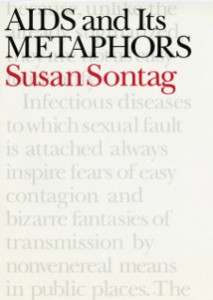Share This:
March 15, 2016 | Notes From Leadership,
Historia as Metaphor by David Dower
In her 1989 book Aids and Its Metaphors, Susan Sontag set about trying to discuss the AIDS pandemic in intellectualized terms, focusing on the mythologizing frames that created distance for the unafflicted, blamed its victims, and inflamed the dialogue surrounding it. She got clobbered by AIDS activists and many of her colleagues for taking something so voracious, so visceral, so immediate and putting it under a literary microscope. AIDS was no metaphor.
I was living in San Francisco at the time. I was surrounded by death and dying, and grief and rage, and fear and death and grief and death and rage and fear and death. And people on the front lines were exhausted by their battle with this monster. At the time, I felt it was the height of hubris and privilege to retreat from the front lines into the safety of metaphor.
Today I have the privileged distance necessary to see the value in her effort. And yet, more than a million people still died from AIDS in 2015, and over 15 million people remain infected with the HIV virus worldwide.
I was reminded of this in preparing to present TeatroCinema’s Historia de Amor. For these Chilean artists, the piece uses the story of a malignant narcissist, a sexual predator, as a metaphoric frame to discuss the fragmented culture left behind by the years of brutal assault on a people under dictator Augusto Pinochet. Now more than a decade in the past, TeatroCinema has both a distance and a point of view on that nation’s nightmare, and they have chosen the the form of the graphic novel and the frame of rape to express it.
And yet, when the piece arrives in Boston, it comes at a time when we don’t have the comfort of distance. We are on a college campus in the year 2016. We are in the midst of a raging debate and a state of alarm over rape culture in our country, with a special focus on rape happening on campus. Emerson College, for its part, has gone to great lengths in battling the rise of sexual assault and providing support services to its victims. This piece is a raw, relentless trip inside the self-justifying pathology of the perpetrator. We do not hear from the victim. Or, rather, we do in the sense that the bully feels himself the victim of her failure to simply allow herself to be his love story. He sees her. He wants her. This will be his Love Story. She has no say in the matter and, so, no voice in this play.
I’ve wrestled with this question of whether, in metaphor, and while in the middle of a college campus, we can find a safe distance from this play today in Boston. And should we even try if we are not sure. And I keep winding up back at the same place. This is precisely the moment to be seeing this story, and this is precisely the form in which to feel its weight and relevance.
Sontag was arguing, both in AIDS and the earlier Illness as Metaphor that the “metaphorizing” tendencies around cancer and AIDS was a coping mechanism that allowed separation between the suffering and the general population. That distance is crucial to the spread of the disease. If it only afflicts “them,” “we” can continue with our regularly scheduled programming.
Historia de Amor obliterates the distance. Rather, it drags you right into the room with the monster. In form, the stark detail of the graphic novel format is doubled by the presence of live actors as both the predator and prey. In narrative, it demands that you look right at it. Rape culture requires bystanders to thrive. Rape culture requires a community that reflexively blames the victim and creates excuses for the perpetrators. Read the early reporting on Phillip Chism, or the “affluenza” defense, or the defense of Ray Rice or Bill Cosby or. . . . Rape culture requires that we hold a space of doubt as to whether she was inviting the attack. No such space will be given in this performance. This is black and white. Literally. This is what it looks like when you encounter it without the benefit of metaphor.
And it’s also all a metaphor.
She is the person dehumanized by another, by a person with power and privilege who has decided he gets to tell her story. And so, Sandra Bland was mentally unstable. Michael Brown had demonic superpowers. Immigrants are criminals. Historia de Amor could be seen as a cautionary tale for our country in this political moment. Bystanders. Bullies. Blame the victim.
Historia de Amor is a story of our time, our place, and our nation. We welcome the perspective of these artists who have lived this story and thank them for coming here to tell it.
David Dower is the co-artistic director of ArtsEmerson.
Historia De Amor runs APR 21 – 24 at The Cutler Majestic Theatre in Dowtown Boston.









Leave a Reply